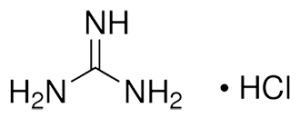Synonyms
aminoformamidine hydrochloride; aminomethanamidine hydrochloride;
guanidinium chloride; GdmCl; GndCl; GuHCl; hydrochloride salt of guanidine
Technical Data
CAS Number: 50-01-1
Molecular Formula: NH2C(=NH)NH2 · HCl
Molecular Weight: 95.53
Beilstein Registry Number: 3591990
EC Number: 200-002-3
FabriChem Specifications
| ITEM | SPECIFICATIONS |
|---|---|
| Clarity & Color of Solution | Clear, colorless |
| Ethyl Alcohol Solution (5%) | Clear |
| Absorbance of Solution: (6M, 20 ± 5° C) At 230 nm At 240 nm At 260 nm | 0.2 Max. 0.05 Max. 0.03 Max. |
| Loss on Drying | 1.0% Max. |
| Residue on Ignition | 0.05% Max. |
| Free-Acid | 0.01% Max. |
| Sulfate | 50 ppm Max. |
| Nitrate | Passes Test |
| Iron | 2 ppm Max. |
| Lead | 0.5 ppm Max. |
| Copper | 0.2 ppm Max. |
| Arsenic | 0.5 ppm Max. |
| Total – CN | 5 ppm Max. |
| Free – CN | 0.1 ppm Max. |
| Purity | 99.5% Min. |
| Solubility (6 Mol/L in DIH2O) | Soluble |
| Solubility (5 w/v% in Ethyl Alcohol) | Soluble |

